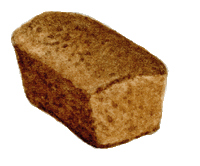Pumpernickel

Form: Unknown
Country of origin: Germany
What distinguishes it from other methods of bread making: Cooked in a pan for hours
Category of bread: (5 and 8) Of all the black breads, pumpernickel is undoubtedly the most characteristic. Nevertheless, the fact that it is cooked in a baking tin and has absolutely no crust encourages us to categorize it among the soft crumb breads
Particularity: Because it is readily spread with caviar, sturgeon or smoked salmon, it is often offered as a luxury bread in upscale boutiques
Ingredients: Rye flour, whole-wheat flour; barley flour (sometimes replaced by bulgur); aniseed; coriander seeds; fennel seeds; caraway seeds; liquid honey; warm water

Germany
Although dark chocolate in color, pumpernickel does not get its color from any artificial coloring or chemical addition, but from the rye, which is its main ingredient, and from the long time it spends in the oven (in a closed baking tin it can in fact stay in the oven for several hours). Like most German breads, pumpernickel plays on the ratio of rye and wheat, but despite it all, it remains one of the blackest of German breads.
The first written mention we have dates from 1450: it talks about a black bread from the region of Westphalia, where it seems to have come from. In German, pumpen can be translated by suffering from flatulence. Nickel is a diminutive of Nicholas, traditionally associated with gnomes, demons or devils. As more well-intentioned dictionaries do, we will continue by saying that pumpernickel can be translated by devil’s fart. Is this a way of saying that this rye bread is not recommended for those with too delicate of a digestive system? Of course no one is obliged to follow this etymological path…
Rye flour, whole-wheat flour, barley flour, aniseed, coriander seeds, fennel seeds, caraway seeds, liquid honey and warm water are kneaded together to obtain a dough that is put in a covered bread pan for 16 to 20 hours, then cooked at a low temperature of 110° C for nearly 6 hours. It is this long cooking time that gives pumpernickel a unique flavor. It is one of these breads that has long ago left its cultural home and blended into a global history of food and gastronomy. Generally speaking, it is seen as a prestige rye sliced crumb bread, which means that is often covered with noble foods such as smoked salmon, caviar, vegetable tartare, etc.

